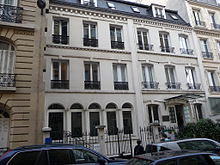St. Albertus Magnus (Paris)
The Catholic parish of German language St. Albertus Magnus has its church in Paris , at 38 Rue Spontini in the 16th arrondissement. It is a community in which mainly Christians from Germany , Austria and Switzerland come together. The building, consisting of two buildings originally designed for residential purposes, is more like a “chapel” as a place of worship and therefore differs from numerous other foreign parishes in Paris.
local community
The German-speaking parish of St. Albertus Magnus in Paris corresponds in its structure and its tasks to the Catholic parishes in Germany . Organizationally and financially, it is largely similar to German parishes, but like all non-French-speaking Catholic parishes in the city, it is under the spiritual direction of the Diocese of Paris . In spite of numerous “non-German” believers - including French Catholics in the immediate vicinity - she is supported personally and materially by the Bishops' Conference in Germany . This sends the pastor and contributes to the budget and thus supplements the financial contribution of the parishioners, because in France , unlike in the three German-speaking countries mentioned, there is no church tax. A "parish council", consisting of ten members elected every four years, supports the pastor in the organizational, financial and spiritual direction. A semi-annual “Community letter” and a monthly (electronic) newsletter (“Albertina”) maintain the connection between the community and its members. The pastor also gives Catholic religious instruction at the "International German School Paris", Saint Cloud. In contrast to the three German-speaking countries, two peculiarities characterize the parish in Paris: a wide distribution of the places of residence of the parishioners, most of whom live in the suburbs of the city - and thus far from "their" parish, and a high fluctuation in the Parishioners - around a quarter of them leave Paris every year - which is due to the fact that their members have lived in the Paris area, which is usually limited for professional reasons.
history
There are records in historical documents that report that German-speaking pastoral care took place in Paris as early as 1627 . This became important in the first half of the 19th century, when a large number of Germans emigrated for economic reasons. a. found work in Paris as a craftsman, worker and garbage collector. According to official documents, there were around 100,000 Germans in 1853, far more than today. During these years pastors accompanied their compatriots, who often lived in poor social conditions. In 1837 the “Mission Catholique de Langue Allemande”, the “Catholic Congregation of the German Language”, is officially founded and the Jesuit Father Joseph Chable is appointed as its leader. It is said that the workers and artisans built their church, " St. Joseph des Allemands ", in Rue Lafayette, in the 10th arrondissement of the city , "with their own hands and money saved from their mouths" . After the First World War the German community was dissolved and the church center of the French community Saint-Joseph-Artisan (St. Joseph the Craftsman). The French policy of the separation of church and state at the beginning of the 20th century (Law on the “Laïcité” 1905) as well as the First World War and its consequences brought difficult times for church work. At the beginning of the 1920s, the community was re-established in the Rue Lhomond, much smaller.
The time of the Second World War was an extraordinarily eventful period for the German-speaking Catholic pastoral care in Paris and was marked by the charismatic pastor Franz Stock . Following his pastoral work since 1934, after the occupation of France in 1940, he was again appointed pastor of the German Catholics in Paris. French Resistance prisoners sentenced to death. There are testimonies of his humanity and the devotion to the condemned and their families. After the end of the war he turned to the German prisoners of war in the Paris area and became the rain of the "seminary behind barbed wire" in Le coudray near Chartres, which existed from 1945 to 1947. Since 1963 his remains have been resting in the church of Saint-Jean-Baptiste in Rechêvre near Chartres. Since then, the French in France and Germans in Germany have kept the memory of Franz Stock alive among friends.
In 1953, independent German-speaking Catholic pastoral care could be resumed in Paris. In 1957, the German Bishops' Conference bought a house on rue Spontini in the 16th arrondissement of the city (today's address) and had it converted into a small parish hall with a chapel. In 1994 the adjoining house was acquired and both were expanded into an enlarged chapel with several community rooms by 1996. After the renovation work was completed, the German priest and painter Sieger Köder created an altarpiece and several windows for the chapel, which are intended to recall the history of German-speaking Catholic pastoral care in Paris and, moreover, German-French history.
literature
- Catholic Congregation German Language 1837 - 1987 , published by the Catholic Congregation German Language St. Albertus Magnus in Paris, 1987.
- Festschrift 50 Years of the Catholic Congregation German Language Paris in Rue Spontini , published by the Catholic Congregation German Language St. Albertus Magnus. Paris 2008.
- Kotterik Gerta, Sellinger Stefan: The miracle of reconciliation. Sieger Köder's works in the German language Catholic community in Paris . Ostfildern 2006.
Web links
Coordinates: 48 ° 52 '7.7 " N , 2 ° 16" 39.2 " E

